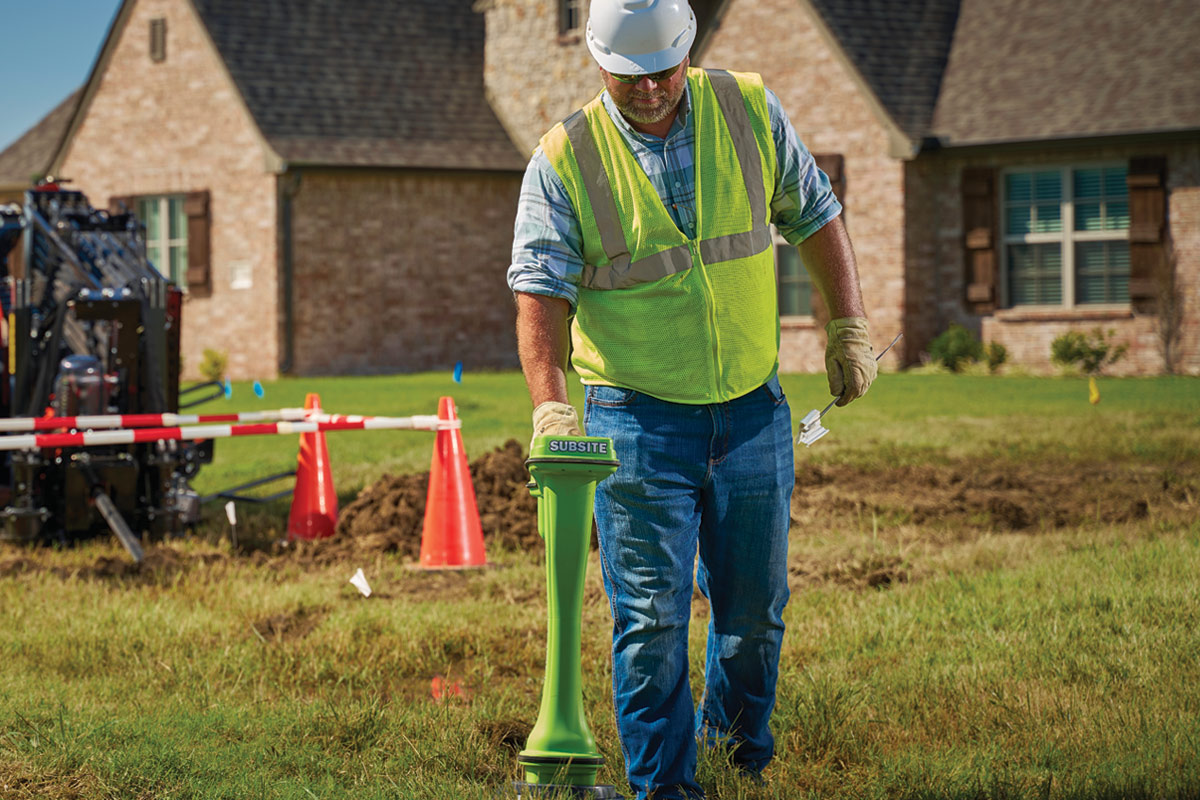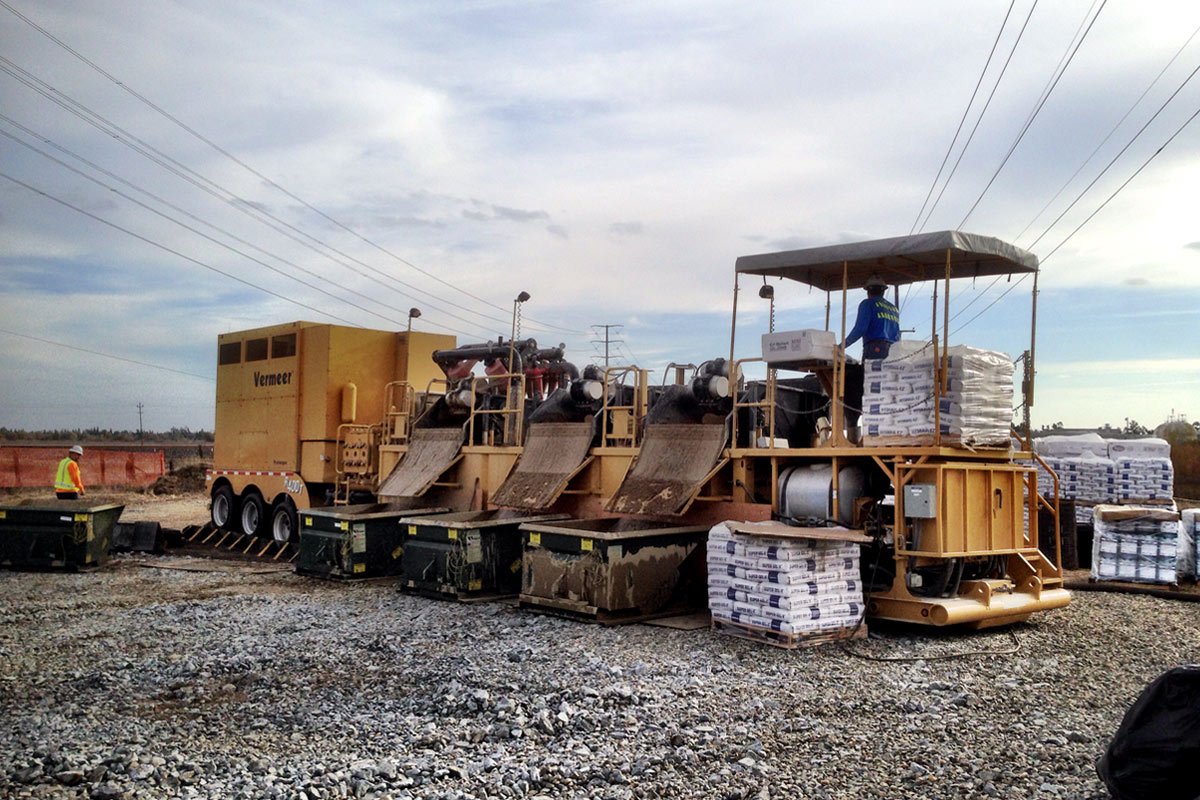Going Trenchless to Upgrade Power for Marine Corps Base Camp Pendleton

When it came time to upgrade the base’s aging power infrastructure, the terrain posed some serious challenges.
Due to strict environmental guidelines and challenging terrain, open-cut excavation simply was not an option. Taking a trenchless approach required a total of approximately 10 large bores and hundreds of smaller bores throughout the base. Arguably the most challenging of the bores was alongside a two-lane road and required crossing under the San Mateo Creek. In fact, before the job was accepted by Riverside Directional Drilling — a family-owned drilling operation since 2003 — it had been deemed impossible.
“Another company had originally been hired to put a line across the same creek, and when they came out to explore the soil conditions, they told the prime consultant that the bore couldn’t be done due to how difficult the geologic conditions were,” Riverside Directional Drilling vice president Victor Cuen explains. “That’s when we were hired.”
Cuen is no stranger to challenging jobs. Having been a directional drill operator in Southern California for nearly 20 years, he is about as familiar with the area’s soil conditions as anyone out there. But this one took the cake.
Cuen and his crew were faced with achieving an 806-ft shot to install a 16-in. DR11 HDPE casing containing four 4-in. PVC conduits. This would serve as the main power source running into the north side of the base. Although Cuen had successfully accomplished much larger shots in the past, it was the geology and the site restrictions that made this one of his more challenging projects.
Planning for the Unknown
Cuen’s team was working off of limited geologic information from the start. “Everyone that had been sent out to do a soil test in the area had drilled down 5 ft and hit refusal,” he says. “They didn’t have anything that would drill through the cobble. So, they couldn’t tell us how deep the bedrock was.”
Although there would be a certain amount of guesswork involved in the initial planning, one thing was for sure — they would need tough equipment. “I took one look at the limited soil report and knew we didn’t have the right shoe for it. You can’t use small-diameter rods in glacial till like that, because it will just push you all over the place,” says Cuen. “So, we decided to go with the Vermeer D100x140 Navigator HDD, because it has a larger rod. I knew it wouldn’t be pushed around or get off course very easily. We also rented a 5¾-in. mud motor, because we knew we’d need a lot of torque to bore through these ground conditions.”
Cuen’s crew was positioned on top of a two-lane road with a steep drop-off and no shoulder. The road remained open, so the crew was only allowed to occupy one lane while accomplishing the bore and following strict safety guidelines.
“We had to set up all of our equipment in a row. We had the Vermeer D100x140 and the pit pump, and then behind that we had our power pack, then the mud separator, then the dump trailer and another truck,” says Cuen. “The whole lineup was at least 200 ft long, and we had to fuel up every day. It just added to the difficulty and time frame of the job.”
Further limiting the workspace were numerous environmental restrictions. “We had an archaeological monitor, a biological monitor, a site safety and health officer, a bird expert and a toad expert on the site every day,” says Cuen. “So, we had to be very diligent about taking precautions to contain our mud.”

Having worked in the area for many years, Cuen knew that he would eventually hit sandstone bedrock on the bore, which would hold the hole without collapsing. With this in mind, he knew he would have to penetrate the glacial fill at a sharp angle and continue through the cobble at a sharp angle to get to the bedrock as quickly as possible.
“I wanted to make the initial run as short as possible, because the cobble varied so much,” explains Cuen. “Through 180 ft of the cobble we drilled, we faced everything from sugar-size sand and pea-size gravel, all the way up to boulders the size of cars. It was a real mess, but we were able to steer it the whole way to the bedrock. We started it at a negative 23 degrees to get through the cobble then kicked it up to 12 and kept drilling.”
Cuen’s crew entered the bedrock at a 25-degree angle, which put them a safe 60 ft beneath the creek. The topography was such that the machine was positioned about 30 ft above the surface of the creek, and the receiving pit was about 60 ft above the surface of the creek on the other side. This meant his crew would need to come back up through the receiving pit at a 30-degree angle.
After getting through the bedrock, Cuen’s crew entered extremely loose, uncompacted till for the last part of the bore. They also had to navigate between two fiber-optic lines in order to get to the receiving pit.
“We only had about a 5-ft window to get between the lines and out of the receiving pit, and it was honestly pretty lucky that we made it,” says Cuen. “We weren’t able to get more than about 1 percent correction on a 20-ft rod, so we just pointed it in the right direction and pushed at 3. We were pushing whole rods at a time, and luckily, we came out right where we needed to be.”
The pilot bore process took about one week. Then the team was ready to begin reaming.
Reaming the Hole
When it came to upsizing the hole, Cuen was able to learn from another crew’s mistakes. “Another crew had done a similar bore on the other side of the hill, and they had chosen to use roller reamers. When they got to the cobble, it pretty much destroyed their reamers beyond repair,” says Cuen. “So, we decided to use stacked plate reamers with a whole lot of teeth on them. We wore out those teeth on almost every ream, but we were able to weld and repair them after each reaming pass, and we actually have the same reamers in use today.”
Cuen’s crew began with a 14-in. stacked plate reamer and trailed the rod to ensure they did not lose the pilot hole. On the next run, they used a 16-in. reamer. Finally, the crew stepped it up to a 24-in. reamer, which they ran through the hole three times. The whole reaming process took about three weeks.
The crew also had to use a high-viscosity mud mix, pumped at 120 gpm on the 24-in. ream to make it through the sandstone. When it came time to pull the pipe back, the crew decided to pull everything back at once, with all four conduits in the casing. The pullback went off without a hitch until hitting the cobble.
“Once we entered the cobble, our pullback pressures started climbing. The ground conditions were so varied that when the reamer came through there, it would just beat up the rocks, and they’d kick back behind the reamer again,” explains Cuen. “Even though there wasn’t much of a hole left due to the kickback of the rocks and cobble, the Vermeer D100x140 was powerful enough to pull back that last 180 ft with no problem. It was a big relief. We all felt such a great sense of accomplishment.”
Cuen and his crew completed the job in a total of six weeks, which by comparison to some of the other crews, was a very impressive timeframe.
“Another crew working on the other side of the hill was doing a similar bore, and it took them about four months,” says Cuen. “They had some equipment problems and ended up snapping their drill head in half and leaving it in the hole. They had to start from scratch. So, I feel pretty good about finishing ours in six weeks.”
Ultimately, Cuen chalks up the project success to his equipment and his crew. “Our guys were extremely professional when working with the environmental and safety regulators, which kept the project moving smoothly without delay,” says Cuen.
John Krantz is a features writer for Two Rivers Marketing, Des Moines, Iowa.





Comments are closed here.